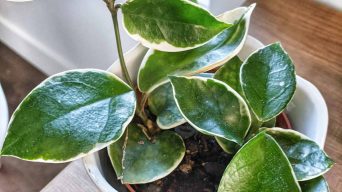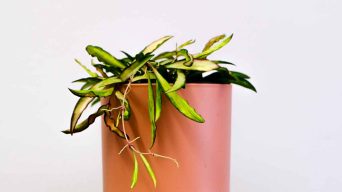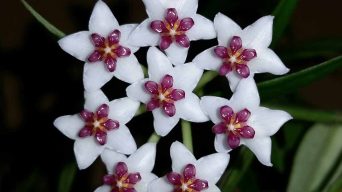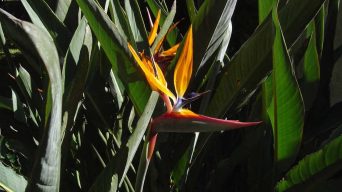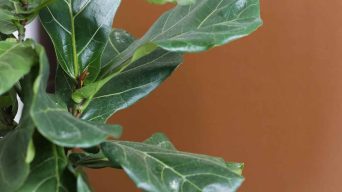White spots on Hoya leaves can result from issues like powdery mildew, pests, sunburn, mineral deposits, chemical burn, or nutrient deficiency. Identifying the cause and taking appropriate measures, such as improving air circulation, treating pests, providing proper lighting and watering, or addressing mineral or chemical issues, can help your Hoya thrive.
Hoya plants are known for their beautiful, waxy leaves, which are often variegated or patterned.
However, sometimes hoya leaves develop white spots.
These spots can be caused by various factors, including pests and diseases.
This article will discuss 6 common causes of white spots on hoya leaves and how to treat and prevent them.
What Causes White Spots on Hoya Leaves?
There are several reasons why your hoya plant might develop white spots.
The most common causes are listed below.
1. Powdery Mildew
Powdery mildew is a type of fungal disease that affects a wide range of plants, including hoyas.
This disease is characterized by developing white, powdery patches on the leaves.
It can also cause the leaves to yellow, curl, and drop off.
Humid conditions and poor air circulation most commonly cause powdery mildew.
How To Tell If Your Hoya Plant Has Powdery Mildew
There are a few key signs to look for if you think your hoya plant has powdery mildew.
These include:
- The presence of white, powdery patches on the leaves
- Yellowing or wilting leaves
- Leaves that are curled or distorted
- Leaf drop
If you see any of these signs, you must take action immediately.
Powdery mildew can spread quickly and be challenging to treat once it takes hold.
How To Treat Powdery Mildew
If you think your hoya plant has powdery mildew, you should first try to improve the air circulation around the plant.
You can do this by moving it to a different location or by increasing the amount of ventilation in the room.
In addition, make sure to water the plant at the base rather than from above, and avoid getting water on the leaves.
If the problem persists, you may need to treat your plant with a natural fungicide.
You can make your own fungicide by mixing one part milk with nine parts water.
Spray the solution on the affected leaves and repeat until the problem is resolved every few days.
You can also use neem oil, a natural insecticide, and fungicide.
Mix two teaspoons of neem oil with one cup of water and spray the solution on the affected leaves.
Repeat every seven to 10 days until the problem is gone.
How To Prevent Powdery Mildew
The best way to prevent powdery mildew is to water your hoya plant at the base and avoid getting water on the leaves.
Overwatering your Hoya can make it susceptible to the disease, so let the soil dry out slightly between waterings.
In addition, make sure to provide good air circulation around the indoor plant by moving it to a different location or increasing ventilation in the room.
Removing any infected leaves as soon as you see them is also essential.
This will help prevent the disease from spreading.
2. Pest Infestation
Pests are another common cause of white spots on hoya leaves.
Aphids, mealybugs, and scale insects are all attracted to hoya plants and can cause damage to the leaves.
These pests feed on the plant sap, which can cause the leaves to turn yellow, curl, and drop off.
In addition, the pests themselves can cause white spots on the leaves.
How To Tell If Your Hoya Plant Has Pests
There are a few key signs to look for if you think your hoya plant has pests.
These include:
- The presence of small, soft-bodied insects on the leaves or stems
- Sticky leaves
- Yellowing or wilting leaves
- Leaves that are curled or distorted
- Leaf drop
If you see any of these signs, you must take action immediately.
Pests can spread quickly and cause a lot of damage to your plant.
How To Treat Pest Infestation
If you think your hoya plant has pests, you should first isolate the plant from other plants.
This will help prevent the pests from spreading.
Next, inspect the plant carefully and remove any insects you see.
Remove them by hand or with a cotton swab dipped in rubbing alcohol.
You can also use a natural insecticide, such as neem oil to treat the plant.
Mix two teaspoons of neem oil with one cup of water and spray the solution on the affected leaves.
Repeat every seven to 10 days until the problem is gone.
How To Prevent Pest Infestation
The best way to prevent pests is to have a healthy hoya plant.
A well-cared-for hoya is less likely to succumb to pests and disease.
Be sure to give your Hoya plenty of bright light, water when the soil is dry, and fertilize during the growing season.
In addition, it’s crucial to inspect your plant regularly for pests and remove them as soon as you see them.
3. Sunburn
Hoya plants are native to tropical regions and need bright indirect light to thrive.
However, the leaves can become sunburned if the plant is exposed to direct sunlight.
This will cause the leaves to turn white or yellow and develop brown spots.
The leaves may also become curled or distorted.
How To Tell If Your Hoya Has Sunburn
There are a few key signs to look for if you think your hoya plant has sunburn.
These include:
- Leaves that are pale or yellowish
- Leaves that have brown spots
- Leaves that are curled or distorted
- Leaves that are falling off
If you see any of these signs, it’s important to take action immediately.
How To Treat Sunburn
If you think your hoya plant has sunburn, you first should move it to a location with indirect sunlight.
You can also try shading the plant with a sheer curtain or placing it in a room with east- or west-facing windows.
You may need to trim off the affected leaves if the sunburn is severe.
How To Prevent Sunburn
The best way to prevent sunburn is to provide your hoya plant with bright indirect light.
You can do this by placing it near an east- or west-facing window.
You can also try shading the plant with a sheer curtain.
A Hoya plant needs 6-8 hours of indirect sunlight per day.
Consider using a grow light if you can’t provide this light.
In addition, it’s important to acclimate your plant to direct sunlight slowly.
Start by exposing it to the sun for only an hour or two per day and gradually increase the amount of time.
4. Mineral Deposits
If you live in an area with hard water, you may notice white spots on the leaves of your hoya plant.
These spots are caused by mineral deposits and are harmless to the plant.
However, they can be unsightly.
Hard water has a high concentration of minerals, such as calcium and magnesium.
These minerals can build up on the leaves of your plant and cause the leaves to turn white or yellow.
How To Tell If Your Hoya Has White Spots From Mineral Deposits
Here are a few key signs to look for if you think your hoya plant has white spots from mineral deposits.
These include:
- The white spots are crusty or flaky
- The white spots are on the upper surface of the leaves
- The white spots can be wiped off with a damp cloth
- The leaves may be yellow or brown around the spots
If you see these signs, your hoya plant likely has white spots from mineral deposits.
How To Treat Mineral Deposits
If you think your hoya plant has white spots from mineral deposits, you can try wiping the spots off with a damp cloth.
You can also try using distilled water or rainwater to water your plant.
If the problem persists, you can try cleaning the leaves with a mixture of 1 part vinegar to 4 parts water.
How To Prevent Mineral Deposits
The best way to prevent mineral deposits is to use distilled water or rainwater to water your plant.
If you live in an area with hard water, you can also try using a water filter.
If you use tap water, be sure to let it sit for 24 hours before watering your plant.
This will give the minerals time to dissipate.
5. Chemical Burn
Another common cause of white spots on hoya leaves is chemical burn.
This can occur if the plant comes into contact with a harsh chemical, such as bleach or insecticide.
It can also occur if you use too much fertilizer.
Chemical burn will cause the leaves to turn white or yellow and develop brown spots.
The leaves may also become curled or distorted.
How To Tell If Your Hoya Has Chemical Burn
There are a few key signs to look for if you think your hoya plant has chemical burn.
These include:
- Leaves that are pale or yellowish
- Leaves that have brown spots
- Leaves that are curled or distorted
- Leaves that are falling off
If you see any of these signs, it’s important to take action immediately.
How To Treat Chemical Burn
If you think your hoya plant has a chemical burn, you should first flush the affected leaves with water.
To do this, place the plant under a running faucet and let the water run over the leaves for several minutes.
You can also try gently washing the leaves with a mild soap.
You can also apply a diluted solution of vinegar to the affected leaves.
To make this solution, mix 1 part vinegar with 4 parts water.
How To Prevent Chemical Burn
The best way to prevent chemical burn is to be careful when handling chemicals near your plant.
If you use insecticides or herbicides, follow the instructions on the label.
You should also be careful when using fertilizers.
Use the recommended amount and be sure to apply it to the soil, not the leaves.
6. Nutrient Deficiency
Nutrient deficiency is another common cause of white spots on hoya leaves.
This can occur if the plant is not getting enough of a specific nutrient, such as iron, calcium, magnesium, copper, or manganese.
A nutrient deficiency will cause the leaves to turn yellow or brown and develop white spots.
The leaves may also become curled or distorted.
How To Tell If Your Hoya Has A Nutrient Deficiency
There are a few key signs to look for if you think your hoya plant has a nutrient deficiency.
These include:
- Yellowing or pale leaves
- Slow growth
- Smaller than normal leaves
- Stunted growth
- White spots on leaves
If you notice any of these signs, it’s important to take action immediately.
How To Treat A Nutrient Deficiency
If you think your hoya plant has a nutrient deficiency, you can try fertilizing it with a balanced fertilizer.
You can also try feeding it with a solution of 1 teaspoon of fertilizer per gallon of water.
To prevent nutrient deficiency, fertilize your hoya plant during the growing season.
You should also be sure to use a fertilizer that is appropriate for your plant.
You can also try adding compost or manure to the soil mix to improve its nutrient content.
How To Prevent Nutrient Deficiency
To prevent nutrient deficiency, it is essential to:
- Use a high-quality potting mix that contains all the necessary nutrients for your plant.
- Fertilize regularly using a balanced fertilizer.
- Water regularly and thoroughly, allowing the soil to dry out between waterings.
- Don’t let your plant sit in water, leading to root rot.
- Place your plant in an area with bright, indirect light.
- Avoid moving your plant around too much, as this can stress the plant and cause nutrient deficiency.
Final Thoughts
Hoya plants are generally low-maintenance and easy to care for.
However, like with any plant, they can sometimes experience issues.
White spots on Hoya leaves are usually an indication of a problem.
There are various possible causes of white spots on Hoya leaves, including powdery mildew, pests, and sunburn.
Luckily, most of these problems can be easily fixed with the proper care.
If you see white spots on your Hoya leaves, inspect the plant carefully to identify the cause.
Once you know what is causing the problem, you can take the necessary steps to fix it.
With some care, your Hoya plant will be healthy and happy in no time!



